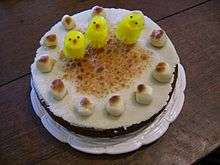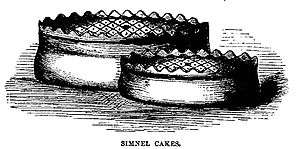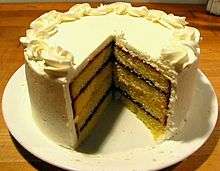Simnel cake
Simnel cake is a light fruitcake formerly eaten during the pre-Easter period in the United Kingdom, Ireland and some other countries but has become a traditional cake for Easter Sunday. It is distinguished by two layers of almond paste or marzipan, one in the middle and one on top. The top layer is capped by a circle of "eggs" made of the same paste, and is lightly browned under a grill. It was originally made for the fourth Sunday in Lent,[1] also known as Laetare Sunday, the Refreshment Sunday of Lent (when the 40-day fast would be relaxed), Mothering Sunday, the Sunday of the Five Loaves,[2] or Simnel Sunday – named after the cake.[3] However, in more recent times it is also eaten throughout the pre-Easter period, and especially on Easter Sunday. While the popularity of simnel cake waned throughout the twentieth century, it has recently enjoyed a marked resurgence, which has been largely attributed to public endorsements by a number of prominent bakers.
.jpg) Simnel cake | |
| Type | Fruitcake |
|---|---|
| Course | Dessert |
| Place of origin | United Kingdom |
Decoration

Conventionally 11, or occasionally 12, marzipan balls are used to decorate the cake, with a story that the balls represent the 12 apostles, minus Judas[1][4][5][6][7][8] or Jesus and the twelve apostles, minus Judas.[9][10] An early reference to decorating with marzipan balls appears in May Byron's Pot-Luck Cookery[11][12] but with no mention of the modern story, and her version may well be derived from earlier styles, which were sometimes crenelated.[13]
Ingredients
Simnel cake is a light fruitcake, generally made from these ingredients: white flour, sugar, butter, eggs, fragrant spices, dried fruits, zest and candied peel. Sometimes orange flower water or brandy is used, either in the cake batter or to flavour the almond paste. In most modern versions marzipan or almond paste is used as a filling for the cake, with a layer laid in the middle of the mix before the cake is cooked, and it is also used as decoration on the top.[14] Most recipes require at least 90 minutes of cooking, and advise using several layers of baking parchment to line the tin, and sometimes brown paper wrapped around the outside to stop the marzipan burning.[15]
History

Simnel cakes have been known since at least medieval times. Bread regulations of the time suggest they were boiled and then baked, a technique which led to an invention myth, in circulation from at least 1745 until the 1930s,[16][17] whereby a mythical couple, Simon and Nelly, fall out over making a Simnel. One wishes to boil it, one to bake it and, after beating each other with various household implements, they compromise on one which uses both cooking techniques.
Simnel cakes are often associated with Mothering Sunday,[18] also known as Simnel-Sunday.[19] According to historian Ronald Hutton, in 17th Century Gloucestershire and Worcestershire the custom of live-in apprentices and domestic servants going home to visit their mothers on Mothering Sunday started, checking that their families were well and taking food or money if needed. This was a time of year when food stocks were low, and the high-calorie simnel cake was useful nutrition.[18] The cake later became simply an Easter cake.[20] The meaning of the word "simnel" is unclear: there is a 1226 reference to "bread made into a simnel", which is understood to mean the finest white bread,[21] from the Latin simila – "fine flour" (from which 'semolina' also derives). John de Garlande felt that the word was equivalent to placenta cake,[3] a cake that was intended to please.[22]
A popular legend attributes the invention of the Simnel cake to Lambert Simnel; however, references to the cake were recorded some 200 years before his birth.
Different towns had their own recipes and shapes of the Simnel cake. Bury, Devizes and Shrewsbury produced large numbers to their own recipes, but it is the Shrewsbury version that became most popular and well known.The illustration is from the 1869, Chambers Book of Days which says :“It is an old custom in Shropshire and Herefordshire, and especially at Shrewsbury, to make during Lent and Easter, and also at Christmas, a sort of rich and expensive cakes, which are called Simnel Cakes. They are raised cakes, the crust of which is made of fine flour and water, with sufficient saffron to give it a deep yellow colour, and the interior is filled with the materials of a very rich plum-cake, with plenty of candied lemon peel, and other good things. They are made up very stiff; tied up in a cloth, and boiled for several hours, after which they are brushed over with egg, and then baked. When ready for sale the crust is as hard as if made of wood, ...... the accompanying engraving, representing large and small cakes as now on sale in Shrewsbury. The usage of these cakes is evidently one of great antiquity.”
References
- "Mothering Sunday". bbc.co.uk. Retrieved 14 July 2012.
-

- Massey, Gerald (2007). A Book of the Beginnings. Cosimo, Inc. p. 269.
- Cory, Lara (19 March 2012). "The Debated History of the Simnel Cake". Retrieved 14 July 2012.
- "Cook the Perfect... Simnel Cake". BBC Radio 4 Woman's Hour. Retrieved 27 September 2012.
- "Traditional Simnel Cake". waitrose.com. Retrieved 14 July 2012.
- "Simnel cake". bbc.co.uk. Retrieved 14 July 2012.
- "Simnel cake recipes". bbc.co.uk. Retrieved 14 July 2012.
- Taylor, Anna-Louise (23 January 2012). "Food symbolism: Why do we give food meaning?". bbc.co.uk. Retrieved 9 April 2012.
- Broomfield, Andrea (2007). Food and cooking in Victorian England: a history. Greenwood Publishing Group. p. 155.
- Byron, May Clarissa Gillington (1926). Pot-luck (7th ed.). p. 421.
- "Gloucester Simnel Cake". The Foods of England. Retrieved 2017-04-28.
- "Shrewsbury Simnel Cake". The Foods of England. Retrieved 2017-04-28.
- "Traditional Simnel Cake Recipe". blog.rachelcotterill.com.
- Cloake, Felicity (2015-03-26). "How to cook the perfect simnel cake". The Guardian. ISSN 0261-3077. Retrieved 2017-04-28.
- Anon (1745). Veillée à la campagne: or, the Simnel. A tale. [In verse.]. London: R. Manby & H. S. Cox.
- "Simnel Cakes". The Times. 21 March 1924.
- Joseph Lee (30 March 2019). "Mother's Day: From medieval brawls to greeting cards and flowers". BBC News.
- "simnel". Oxford English Dictionary (3rd ed.). Oxford University Press. September 2005. (Subscription or UK public library membership required.)
- Davidson, Alan (2014). The Oxford Companion to Food. Oxford University Press. ISBN 9780199677337.
- Harland, John; Wilkinson, Thomas Turner (1867). Lancashire folk-lore. F. Warne. pp. 223–224.
- Toussaint-Samat, Maguelonne (2009). A History of Food. John Wiley & Sons. p. 206.
| Wikimedia Commons has media related to Simnel cakes. |
